Essay: Cultural Transformations Across Two Indian Generations
VerifiedAdded on 2023/06/09
|6
|1989
|313
Essay
AI Summary
This essay explores the significant transformations in Indian culture over two generations, drawing insights from an interview with the author's grandfather. The essay highlights key changes, including the evolving role of women, advancements in education, and the impact of technology. It contrasts the challenges faced by previous generations with the opportunities and pressures of the present, particularly concerning education, career ambitions, and family dynamics. The author discusses the shift in societal values, emphasizing the increased importance of education, the rise of competition, and the changing balance between work and family life. The essay concludes by reflecting on how these changes have reshaped the cultural landscape of India, acknowledging both the progress and the challenges associated with modernization.
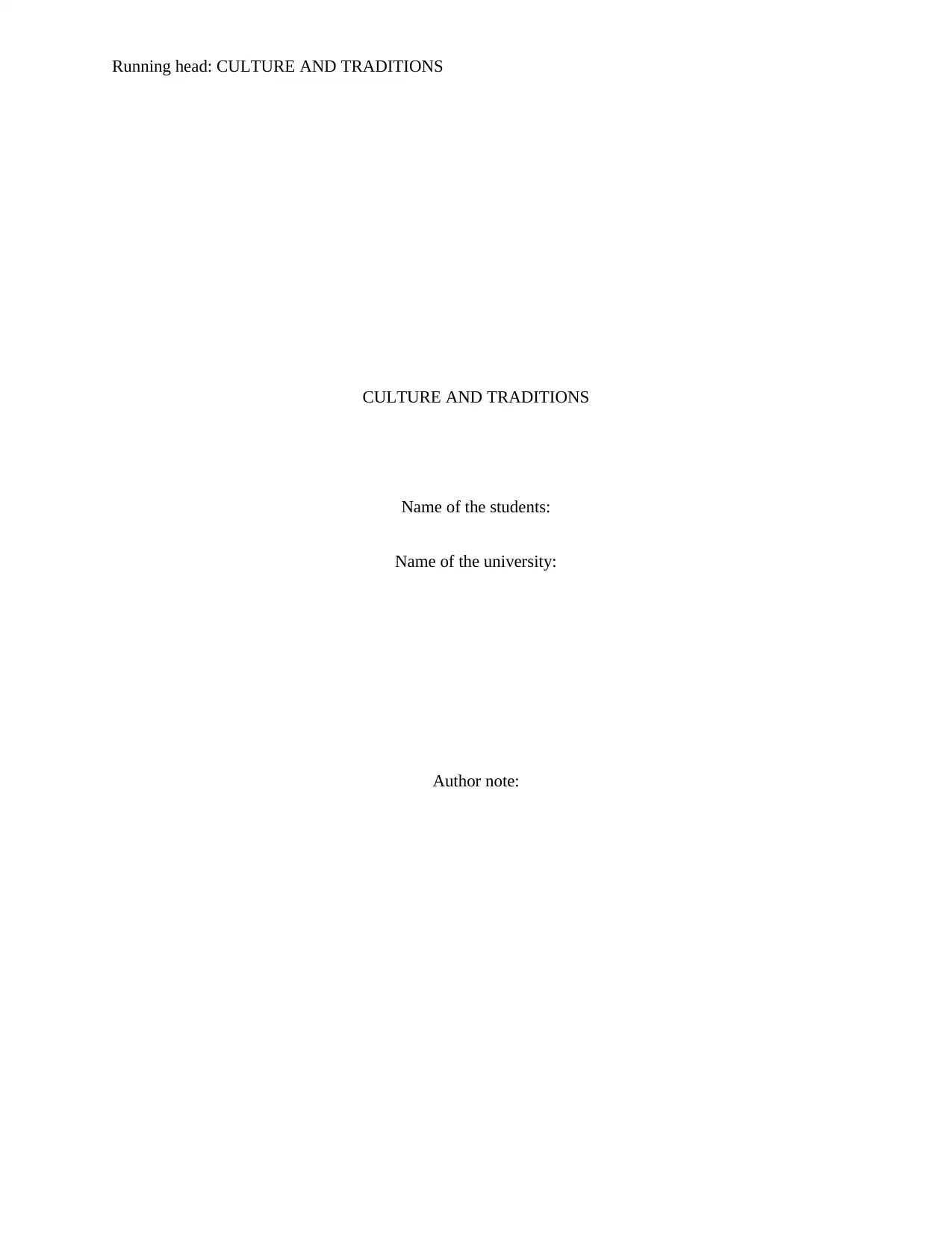
Running head: CULTURE AND TRADITIONS
CULTURE AND TRADITIONS
Name of the students:
Name of the university:
Author note:
CULTURE AND TRADITIONS
Name of the students:
Name of the university:
Author note:
Paraphrase This Document
Need a fresh take? Get an instant paraphrase of this document with our AI Paraphraser
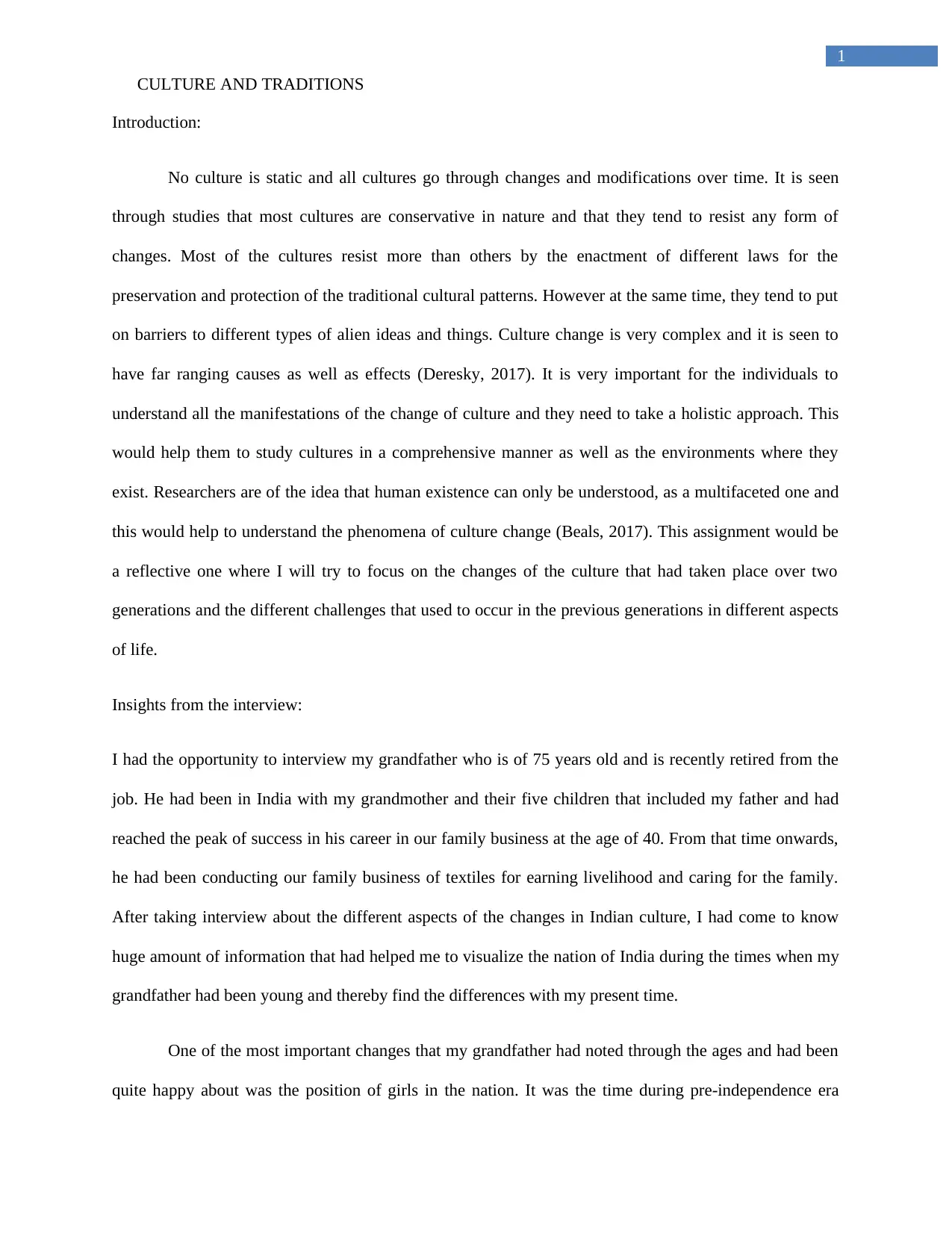
1
CULTURE AND TRADITIONS
Introduction:
No culture is static and all cultures go through changes and modifications over time. It is seen
through studies that most cultures are conservative in nature and that they tend to resist any form of
changes. Most of the cultures resist more than others by the enactment of different laws for the
preservation and protection of the traditional cultural patterns. However at the same time, they tend to put
on barriers to different types of alien ideas and things. Culture change is very complex and it is seen to
have far ranging causes as well as effects (Deresky, 2017). It is very important for the individuals to
understand all the manifestations of the change of culture and they need to take a holistic approach. This
would help them to study cultures in a comprehensive manner as well as the environments where they
exist. Researchers are of the idea that human existence can only be understood, as a multifaceted one and
this would help to understand the phenomena of culture change (Beals, 2017). This assignment would be
a reflective one where I will try to focus on the changes of the culture that had taken place over two
generations and the different challenges that used to occur in the previous generations in different aspects
of life.
Insights from the interview:
I had the opportunity to interview my grandfather who is of 75 years old and is recently retired from the
job. He had been in India with my grandmother and their five children that included my father and had
reached the peak of success in his career in our family business at the age of 40. From that time onwards,
he had been conducting our family business of textiles for earning livelihood and caring for the family.
After taking interview about the different aspects of the changes in Indian culture, I had come to know
huge amount of information that had helped me to visualize the nation of India during the times when my
grandfather had been young and thereby find the differences with my present time.
One of the most important changes that my grandfather had noted through the ages and had been
quite happy about was the position of girls in the nation. It was the time during pre-independence era
CULTURE AND TRADITIONS
Introduction:
No culture is static and all cultures go through changes and modifications over time. It is seen
through studies that most cultures are conservative in nature and that they tend to resist any form of
changes. Most of the cultures resist more than others by the enactment of different laws for the
preservation and protection of the traditional cultural patterns. However at the same time, they tend to put
on barriers to different types of alien ideas and things. Culture change is very complex and it is seen to
have far ranging causes as well as effects (Deresky, 2017). It is very important for the individuals to
understand all the manifestations of the change of culture and they need to take a holistic approach. This
would help them to study cultures in a comprehensive manner as well as the environments where they
exist. Researchers are of the idea that human existence can only be understood, as a multifaceted one and
this would help to understand the phenomena of culture change (Beals, 2017). This assignment would be
a reflective one where I will try to focus on the changes of the culture that had taken place over two
generations and the different challenges that used to occur in the previous generations in different aspects
of life.
Insights from the interview:
I had the opportunity to interview my grandfather who is of 75 years old and is recently retired from the
job. He had been in India with my grandmother and their five children that included my father and had
reached the peak of success in his career in our family business at the age of 40. From that time onwards,
he had been conducting our family business of textiles for earning livelihood and caring for the family.
After taking interview about the different aspects of the changes in Indian culture, I had come to know
huge amount of information that had helped me to visualize the nation of India during the times when my
grandfather had been young and thereby find the differences with my present time.
One of the most important changes that my grandfather had noted through the ages and had been
quite happy about was the position of girls in the nation. It was the time during pre-independence era
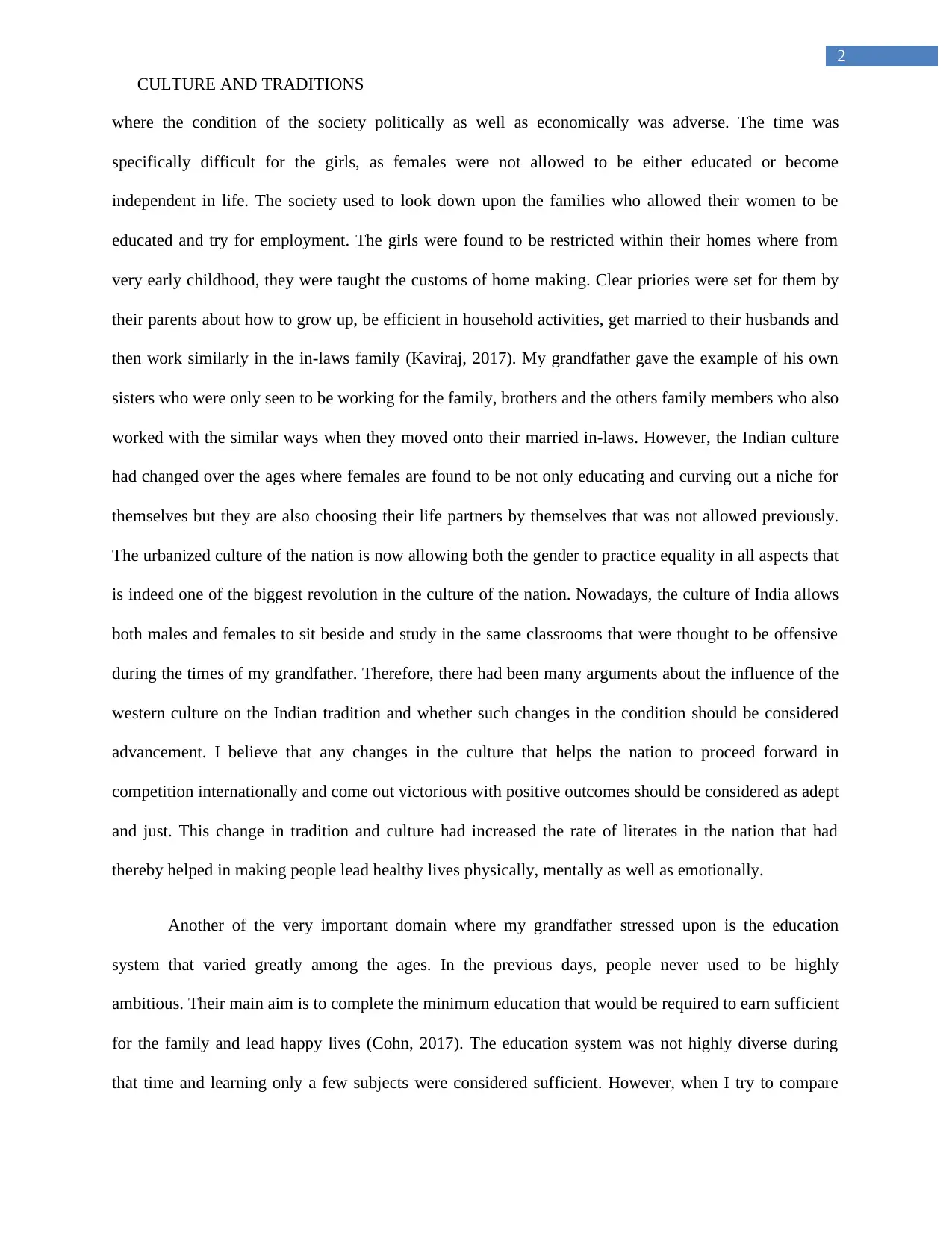
2
CULTURE AND TRADITIONS
where the condition of the society politically as well as economically was adverse. The time was
specifically difficult for the girls, as females were not allowed to be either educated or become
independent in life. The society used to look down upon the families who allowed their women to be
educated and try for employment. The girls were found to be restricted within their homes where from
very early childhood, they were taught the customs of home making. Clear priories were set for them by
their parents about how to grow up, be efficient in household activities, get married to their husbands and
then work similarly in the in-laws family (Kaviraj, 2017). My grandfather gave the example of his own
sisters who were only seen to be working for the family, brothers and the others family members who also
worked with the similar ways when they moved onto their married in-laws. However, the Indian culture
had changed over the ages where females are found to be not only educating and curving out a niche for
themselves but they are also choosing their life partners by themselves that was not allowed previously.
The urbanized culture of the nation is now allowing both the gender to practice equality in all aspects that
is indeed one of the biggest revolution in the culture of the nation. Nowadays, the culture of India allows
both males and females to sit beside and study in the same classrooms that were thought to be offensive
during the times of my grandfather. Therefore, there had been many arguments about the influence of the
western culture on the Indian tradition and whether such changes in the condition should be considered
advancement. I believe that any changes in the culture that helps the nation to proceed forward in
competition internationally and come out victorious with positive outcomes should be considered as adept
and just. This change in tradition and culture had increased the rate of literates in the nation that had
thereby helped in making people lead healthy lives physically, mentally as well as emotionally.
Another of the very important domain where my grandfather stressed upon is the education
system that varied greatly among the ages. In the previous days, people never used to be highly
ambitious. Their main aim is to complete the minimum education that would be required to earn sufficient
for the family and lead happy lives (Cohn, 2017). The education system was not highly diverse during
that time and learning only a few subjects were considered sufficient. However, when I try to compare
CULTURE AND TRADITIONS
where the condition of the society politically as well as economically was adverse. The time was
specifically difficult for the girls, as females were not allowed to be either educated or become
independent in life. The society used to look down upon the families who allowed their women to be
educated and try for employment. The girls were found to be restricted within their homes where from
very early childhood, they were taught the customs of home making. Clear priories were set for them by
their parents about how to grow up, be efficient in household activities, get married to their husbands and
then work similarly in the in-laws family (Kaviraj, 2017). My grandfather gave the example of his own
sisters who were only seen to be working for the family, brothers and the others family members who also
worked with the similar ways when they moved onto their married in-laws. However, the Indian culture
had changed over the ages where females are found to be not only educating and curving out a niche for
themselves but they are also choosing their life partners by themselves that was not allowed previously.
The urbanized culture of the nation is now allowing both the gender to practice equality in all aspects that
is indeed one of the biggest revolution in the culture of the nation. Nowadays, the culture of India allows
both males and females to sit beside and study in the same classrooms that were thought to be offensive
during the times of my grandfather. Therefore, there had been many arguments about the influence of the
western culture on the Indian tradition and whether such changes in the condition should be considered
advancement. I believe that any changes in the culture that helps the nation to proceed forward in
competition internationally and come out victorious with positive outcomes should be considered as adept
and just. This change in tradition and culture had increased the rate of literates in the nation that had
thereby helped in making people lead healthy lives physically, mentally as well as emotionally.
Another of the very important domain where my grandfather stressed upon is the education
system that varied greatly among the ages. In the previous days, people never used to be highly
ambitious. Their main aim is to complete the minimum education that would be required to earn sufficient
for the family and lead happy lives (Cohn, 2017). The education system was not highly diverse during
that time and learning only a few subjects were considered sufficient. However, when I try to compare
⊘ This is a preview!⊘
Do you want full access?
Subscribe today to unlock all pages.

Trusted by 1+ million students worldwide
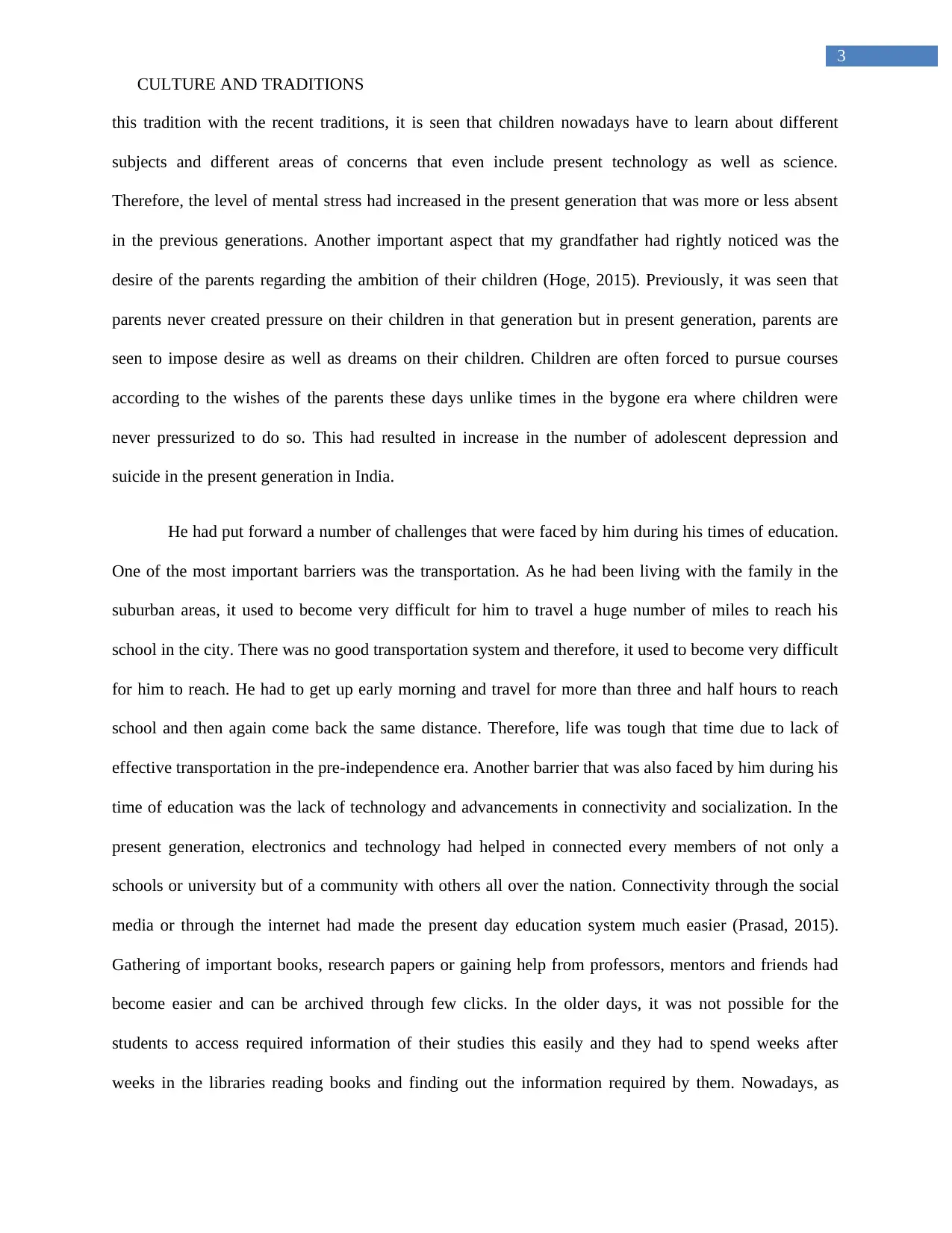
3
CULTURE AND TRADITIONS
this tradition with the recent traditions, it is seen that children nowadays have to learn about different
subjects and different areas of concerns that even include present technology as well as science.
Therefore, the level of mental stress had increased in the present generation that was more or less absent
in the previous generations. Another important aspect that my grandfather had rightly noticed was the
desire of the parents regarding the ambition of their children (Hoge, 2015). Previously, it was seen that
parents never created pressure on their children in that generation but in present generation, parents are
seen to impose desire as well as dreams on their children. Children are often forced to pursue courses
according to the wishes of the parents these days unlike times in the bygone era where children were
never pressurized to do so. This had resulted in increase in the number of adolescent depression and
suicide in the present generation in India.
He had put forward a number of challenges that were faced by him during his times of education.
One of the most important barriers was the transportation. As he had been living with the family in the
suburban areas, it used to become very difficult for him to travel a huge number of miles to reach his
school in the city. There was no good transportation system and therefore, it used to become very difficult
for him to reach. He had to get up early morning and travel for more than three and half hours to reach
school and then again come back the same distance. Therefore, life was tough that time due to lack of
effective transportation in the pre-independence era. Another barrier that was also faced by him during his
time of education was the lack of technology and advancements in connectivity and socialization. In the
present generation, electronics and technology had helped in connected every members of not only a
schools or university but of a community with others all over the nation. Connectivity through the social
media or through the internet had made the present day education system much easier (Prasad, 2015).
Gathering of important books, research papers or gaining help from professors, mentors and friends had
become easier and can be archived through few clicks. In the older days, it was not possible for the
students to access required information of their studies this easily and they had to spend weeks after
weeks in the libraries reading books and finding out the information required by them. Nowadays, as
CULTURE AND TRADITIONS
this tradition with the recent traditions, it is seen that children nowadays have to learn about different
subjects and different areas of concerns that even include present technology as well as science.
Therefore, the level of mental stress had increased in the present generation that was more or less absent
in the previous generations. Another important aspect that my grandfather had rightly noticed was the
desire of the parents regarding the ambition of their children (Hoge, 2015). Previously, it was seen that
parents never created pressure on their children in that generation but in present generation, parents are
seen to impose desire as well as dreams on their children. Children are often forced to pursue courses
according to the wishes of the parents these days unlike times in the bygone era where children were
never pressurized to do so. This had resulted in increase in the number of adolescent depression and
suicide in the present generation in India.
He had put forward a number of challenges that were faced by him during his times of education.
One of the most important barriers was the transportation. As he had been living with the family in the
suburban areas, it used to become very difficult for him to travel a huge number of miles to reach his
school in the city. There was no good transportation system and therefore, it used to become very difficult
for him to reach. He had to get up early morning and travel for more than three and half hours to reach
school and then again come back the same distance. Therefore, life was tough that time due to lack of
effective transportation in the pre-independence era. Another barrier that was also faced by him during his
time of education was the lack of technology and advancements in connectivity and socialization. In the
present generation, electronics and technology had helped in connected every members of not only a
schools or university but of a community with others all over the nation. Connectivity through the social
media or through the internet had made the present day education system much easier (Prasad, 2015).
Gathering of important books, research papers or gaining help from professors, mentors and friends had
become easier and can be archived through few clicks. In the older days, it was not possible for the
students to access required information of their studies this easily and they had to spend weeks after
weeks in the libraries reading books and finding out the information required by them. Nowadays, as
Paraphrase This Document
Need a fresh take? Get an instant paraphrase of this document with our AI Paraphraser
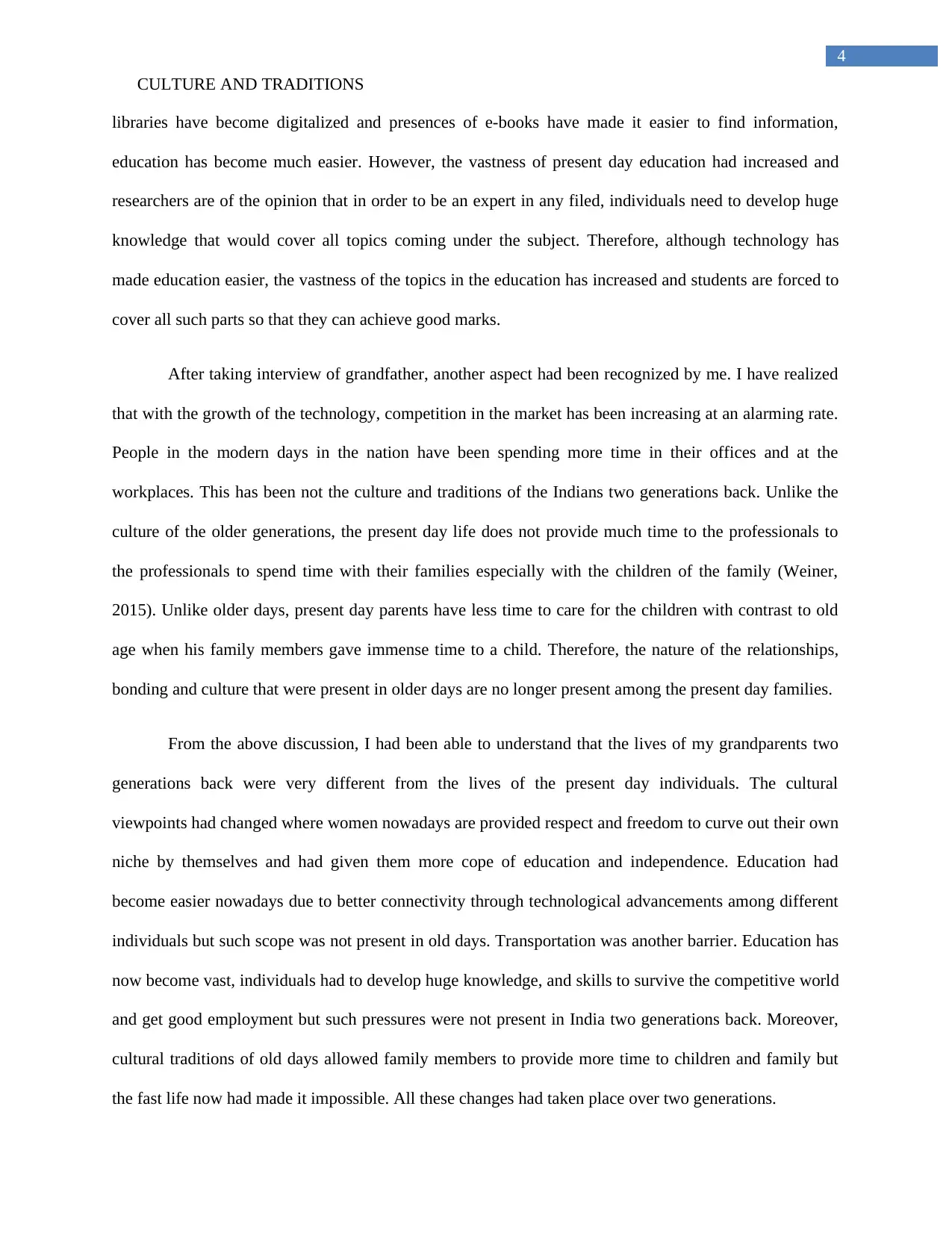
4
CULTURE AND TRADITIONS
libraries have become digitalized and presences of e-books have made it easier to find information,
education has become much easier. However, the vastness of present day education had increased and
researchers are of the opinion that in order to be an expert in any filed, individuals need to develop huge
knowledge that would cover all topics coming under the subject. Therefore, although technology has
made education easier, the vastness of the topics in the education has increased and students are forced to
cover all such parts so that they can achieve good marks.
After taking interview of grandfather, another aspect had been recognized by me. I have realized
that with the growth of the technology, competition in the market has been increasing at an alarming rate.
People in the modern days in the nation have been spending more time in their offices and at the
workplaces. This has been not the culture and traditions of the Indians two generations back. Unlike the
culture of the older generations, the present day life does not provide much time to the professionals to
the professionals to spend time with their families especially with the children of the family (Weiner,
2015). Unlike older days, present day parents have less time to care for the children with contrast to old
age when his family members gave immense time to a child. Therefore, the nature of the relationships,
bonding and culture that were present in older days are no longer present among the present day families.
From the above discussion, I had been able to understand that the lives of my grandparents two
generations back were very different from the lives of the present day individuals. The cultural
viewpoints had changed where women nowadays are provided respect and freedom to curve out their own
niche by themselves and had given them more cope of education and independence. Education had
become easier nowadays due to better connectivity through technological advancements among different
individuals but such scope was not present in old days. Transportation was another barrier. Education has
now become vast, individuals had to develop huge knowledge, and skills to survive the competitive world
and get good employment but such pressures were not present in India two generations back. Moreover,
cultural traditions of old days allowed family members to provide more time to children and family but
the fast life now had made it impossible. All these changes had taken place over two generations.
CULTURE AND TRADITIONS
libraries have become digitalized and presences of e-books have made it easier to find information,
education has become much easier. However, the vastness of present day education had increased and
researchers are of the opinion that in order to be an expert in any filed, individuals need to develop huge
knowledge that would cover all topics coming under the subject. Therefore, although technology has
made education easier, the vastness of the topics in the education has increased and students are forced to
cover all such parts so that they can achieve good marks.
After taking interview of grandfather, another aspect had been recognized by me. I have realized
that with the growth of the technology, competition in the market has been increasing at an alarming rate.
People in the modern days in the nation have been spending more time in their offices and at the
workplaces. This has been not the culture and traditions of the Indians two generations back. Unlike the
culture of the older generations, the present day life does not provide much time to the professionals to
the professionals to spend time with their families especially with the children of the family (Weiner,
2015). Unlike older days, present day parents have less time to care for the children with contrast to old
age when his family members gave immense time to a child. Therefore, the nature of the relationships,
bonding and culture that were present in older days are no longer present among the present day families.
From the above discussion, I had been able to understand that the lives of my grandparents two
generations back were very different from the lives of the present day individuals. The cultural
viewpoints had changed where women nowadays are provided respect and freedom to curve out their own
niche by themselves and had given them more cope of education and independence. Education had
become easier nowadays due to better connectivity through technological advancements among different
individuals but such scope was not present in old days. Transportation was another barrier. Education has
now become vast, individuals had to develop huge knowledge, and skills to survive the competitive world
and get good employment but such pressures were not present in India two generations back. Moreover,
cultural traditions of old days allowed family members to provide more time to children and family but
the fast life now had made it impossible. All these changes had taken place over two generations.
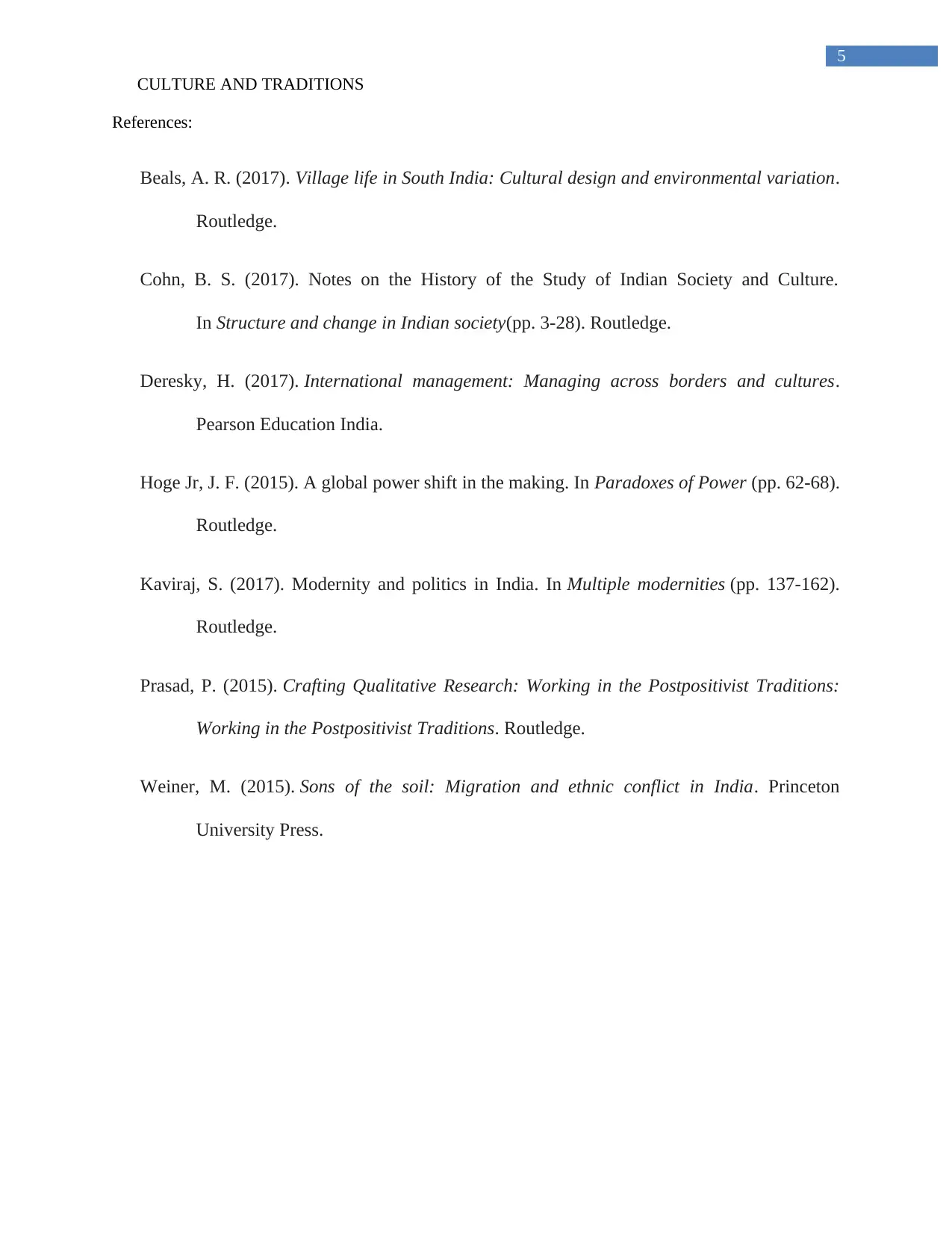
5
CULTURE AND TRADITIONS
References:
Beals, A. R. (2017). Village life in South India: Cultural design and environmental variation.
Routledge.
Cohn, B. S. (2017). Notes on the History of the Study of Indian Society and Culture.
In Structure and change in Indian society(pp. 3-28). Routledge.
Deresky, H. (2017). International management: Managing across borders and cultures.
Pearson Education India.
Hoge Jr, J. F. (2015). A global power shift in the making. In Paradoxes of Power (pp. 62-68).
Routledge.
Kaviraj, S. (2017). Modernity and politics in India. In Multiple modernities (pp. 137-162).
Routledge.
Prasad, P. (2015). Crafting Qualitative Research: Working in the Postpositivist Traditions:
Working in the Postpositivist Traditions. Routledge.
Weiner, M. (2015). Sons of the soil: Migration and ethnic conflict in India. Princeton
University Press.
CULTURE AND TRADITIONS
References:
Beals, A. R. (2017). Village life in South India: Cultural design and environmental variation.
Routledge.
Cohn, B. S. (2017). Notes on the History of the Study of Indian Society and Culture.
In Structure and change in Indian society(pp. 3-28). Routledge.
Deresky, H. (2017). International management: Managing across borders and cultures.
Pearson Education India.
Hoge Jr, J. F. (2015). A global power shift in the making. In Paradoxes of Power (pp. 62-68).
Routledge.
Kaviraj, S. (2017). Modernity and politics in India. In Multiple modernities (pp. 137-162).
Routledge.
Prasad, P. (2015). Crafting Qualitative Research: Working in the Postpositivist Traditions:
Working in the Postpositivist Traditions. Routledge.
Weiner, M. (2015). Sons of the soil: Migration and ethnic conflict in India. Princeton
University Press.
⊘ This is a preview!⊘
Do you want full access?
Subscribe today to unlock all pages.

Trusted by 1+ million students worldwide
1 out of 6
Related Documents
Your All-in-One AI-Powered Toolkit for Academic Success.
+13062052269
info@desklib.com
Available 24*7 on WhatsApp / Email
![[object Object]](/_next/static/media/star-bottom.7253800d.svg)
Unlock your academic potential
Copyright © 2020–2025 A2Z Services. All Rights Reserved. Developed and managed by ZUCOL.




